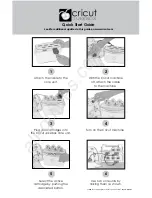
8
OPERATION
STEP 1
Use an appropriate tool like the Norfield Stylizer II to mortise the door for the
Eurogroove.
STEP 2
Place the fixture on the door with the End Stop against the end of the door. Ensure that
the fixtures sit flat on the edge of the door with the alignment blocks fully inserted in the
Eurogroove (Detail A in fig. 3). Tighten the Door Clamps on each fixture.
STEP 3
Setup a plunge router with a ½” diameter bit (Norfield P/N WHI10731) and a 13/16”
template guide (Norfield P/N NOR62949). The bit should not project more than ¾” from
the router base when the bit is fully retracted. Determine the mortise depth for the lock
bodies and set a plunge depth stop accordingly. Mortise the pockets starting with the
plunge depth set as shallow as possible. Make multiple passes increasing the plunge
depth on each pass until the desired depth is achieved. Most plunge routers have a
maximum plunge of approximately 2”. If the required depth is greater than approximately
2” make the mortise 2” deep and then reposition the bit in the router to make the deeper
cut. Remove the bit and locking nut with collet. Reposition the router bit so that it is flush
with the top of the collet and reinstall in the router. This should provide a mortise depth
of approximately 3”.
Note: To optimize production time, a second router may be setup for the
deeper mortise requirement.
WARNINGS
DO NOT Install the router bit with the top of the bit below the top of the collet as
the bit could come loose during operation.
DO NOT Insert the router bit through template slot with router running
This will greatly increase the risk of injury to the operator and increase the
potential of permanent damage to templates and the fixture.
STEP 4
Using the plunge router, now in a horizontal position, mortise for the lock function holes.
Again, use multiple passes on each hole until the bit passes through the door.
DOUBLE DOORS
The inactive door in a double or French door unit can be processed as above before the t-
astragal is installed.
STRIKE PLATES
The accurate locations of the strike plates are very important. It is recommended that
their locations should be measured from the top of the door. This will help insure proper
placement in relationship to the clearance between the top of the door and the frame head
jamb. Measure from the top of the door to each of the centerlines on the door mortising
fixture. Be sure to make any adjustment necessary for header clearance. Mark these
locations for the strike plates. You can now use the appropriate tools to mortise for the
strike plates.
STRIKE PLATES ON A JAMB































